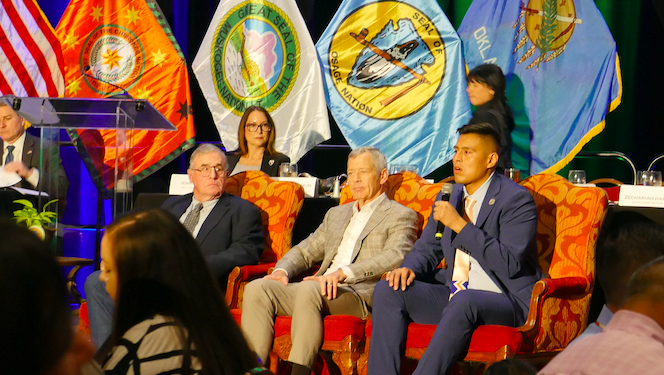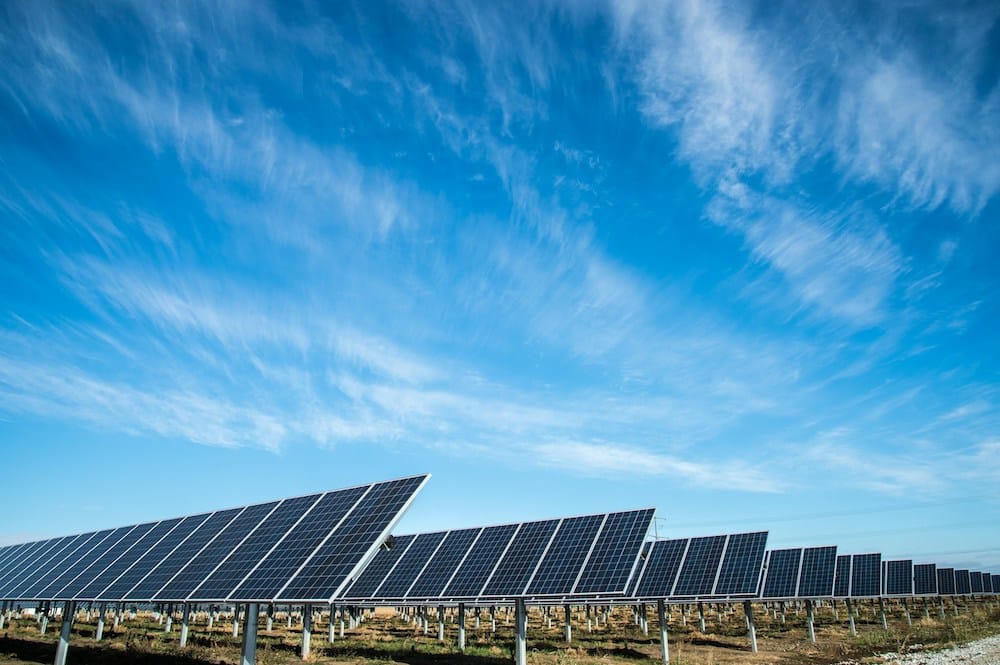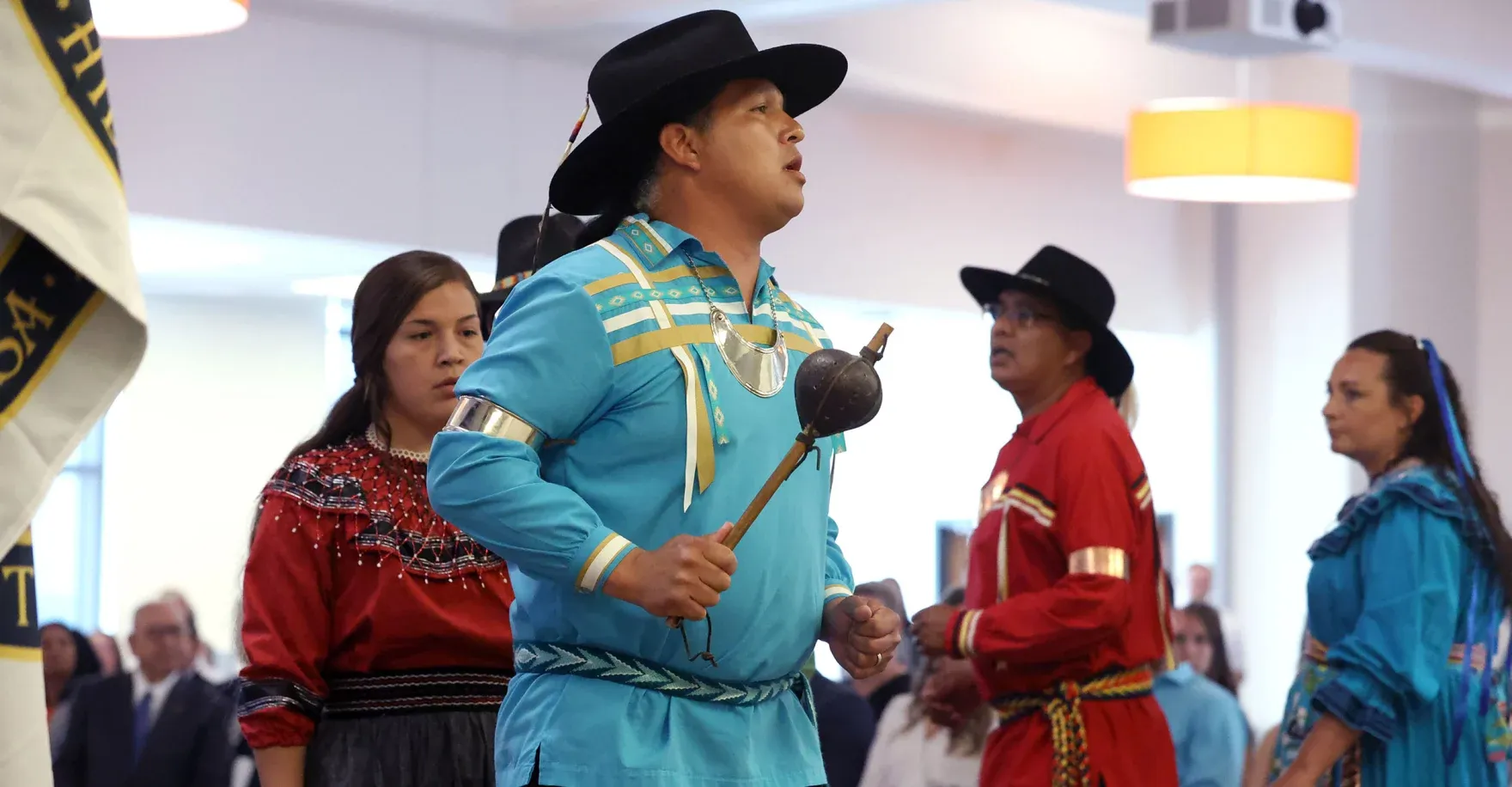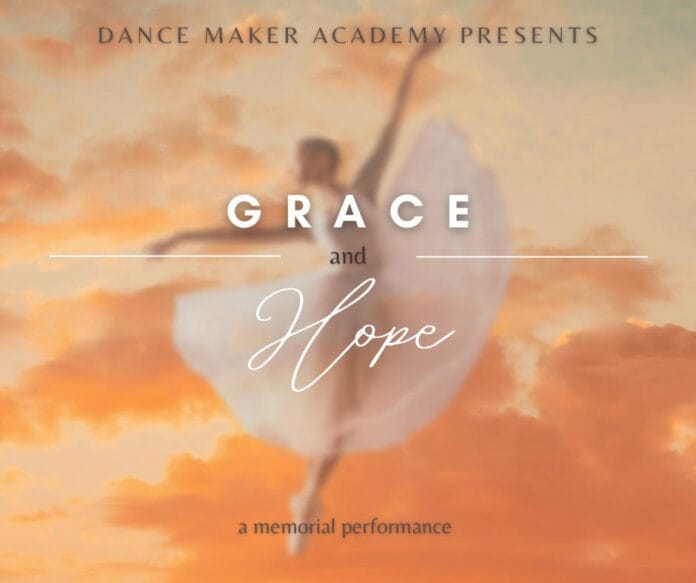

MCN discusses progress and development at State of the Tribal Nations luncheon

Tulsa Regional Chamber of Commerce holds inaugural event
TVLSE, Oklv. – The Tulsa Regional Chamber of Commerce held their inaugural State of the Tribal Nations’ event at the Tulsa Renaissance Center on Thursday, April 18. The fully booked luncheon event featured panel discussions with representatives from the three major Tulsa area tribes. Representatives of the Muscogee (Creek) Nation, the Cherokee Nation, and the Osage Nation spoke about economic developments, tourism, and cultural education programs.
“…it’s important that our voices are part of the decisions that are made in our communities…” – RaeLynn Butler, MCN Secretary of Culture and Humanities
MCN Secretary of the Nation Zechariah Harjo and Secretary of Culture and Humanities RaeLynn Butler attended the event. The event began with a land acknowledgement given by Butler. As becoming common practice at public events and gatherings, acknowledgements recognize the Indigenous stakeholders and original inhabitants of the land. Butler acknowledged the Osage Nation, Cherokee Nation, and MCN as well as the Caddo and Quapaw who inhabited the land before the removals.
The event featured a discussion with Cherokee Nation Principal Chief Chuck Hoskin, Jr and Osage Nation Principal Chief Geoffrey Standing Bear. Chief Hoskin emphasized a theme throughout the event, the partnerships necessary for success within the state. He said,
“The Cherokee word Gadugi, working together. So, you would look at what we’re doing in the state, we’re indispensable. We’re inextricably linked to whether this state is going to succeed or whether it’s going to fail. And it’s going to succeed because the Cherokee people were meant to succeed. As long as we’re working together, I think, success is just in our DNA.”
Harjo, speaking about tribal economic development, highlighted many collaborative development projects, like the south Tulsa and Jenks Low Water Dam project, and emphasized the opportunities for partnering with Tribal Nations. He said, “So our economic development is really surrounding the support of the communities and we have a number of projects that demonstrate that from the City of Tulsa all the way through our own communities and throughout our reservation.”
Discussions also included examples of progress in infrastructure development, health technology, energy, and rural broadband access. Harjo also spoke about the intersections of technology and education, addressing access for Native students in STEM fields.
In her remarks, Butler focused on the importance of Mvskoke cultural resilience, sharing of history, and plans for an MCN welcome center and museum. She said: “With the Mvskoke Nation, culture is our foundation. We wouldn’t be who we are without our culture, without our language. We maintain our traditional ways of life, our churches. And we have great pride and have longevity in maintaining that culture I think, which is critical to moving forward. So, our mission is really to try to preserve, protect, but also to promote and help the next generation to keep moving forward in this place.”
The significance of land acknowledgement was something not to be underscored at Thursday’s event. In answer to a broad question about non-Native understandings of history, Butler replied:
“Everybody who lives south of Admiral Street or works out in Admiral is probably on a Mvskoke allotment. We can tell you who lived there. We can help you develop a land acknowledgment. We can help you tell our history and our stories of these lands… You know, there’s a lot of opportunities to partner with us. We’re seeing the most growth in our Nation and others at this time… Our hands are out ready to meet new people and to build partnerships with everybody because we do feel it’s important that our voices are part of the decisions that are made in our communities, but also that our history is full practically. You know, if you’re learning our history from a book, most likely it wasn’t written by us. And so it’s important for you to reach out to the Nation directly. We can help get you in touch with the right people.”
The event was well attended by local and area groups. These included businesses and community partners like Arvest Bank, Tulsa World, and the Grand River Dam Authority.
Also featured at the event were the Tulsa Indian Club singers and a performance by Native Praise Choir. The event was sponsored by TRCC partners Thompson Construction and Vast.bank.

$7 billion Solar For All initiative awards over $500 million to empower tribal communities with clean energy

There's more than $500 million headed to Indian Country to pay for solar energy workforce training, technical assistance, and an array of projects such as residential solar arrays.
The money is part of a $7 billion funding pot under the Environmental Protection Agency's Solar For All initiative, or SFA. Tribes, tribal nonprofit groups, and tribal consortiums received roughly $504 million as part of the award funding, announced Monday. Millions more are expected pour into Indian Country through pledged support from states and nonprofits across the country that were also given SFA awards.
One tribal-focused group is Sacramento, Calif.-based solar nonprofit GRID Alternatives. The organization’s National Tribal Program received a $62.5 million award to help with capacity building and technical assistance for tribal solar projects.
Talia Martin, GRID’s national tribal program co-director, estimated that roughly 75% of its award money will go directly toward workforce development. The remainder will support technical assistance for projects such as generators or batteries.
Martin, a member of the Shoshone-Bannock Tribes, said GRID was “ecstatic” to receive money that would create jobs and support clean energy for tribal citizens and Native communities.
“Because we’re tribal-led, we want to be able to create jobs for our Indigenous professionals out there in the clean energy field,” Martin told Tribal Business News on Monday.
The Northern Plains Tribal Coalition, composed of 14 tribes across Wisconsin, North Dakota, South Dakota, Wyoming, and Montana, also received $135.6 million in SFA grant funding. The group has partnered with Indigenized Energy, an initiative of San Diego-based nonprofit Mission Edge, to develop their solar program.
Indigenized Energy Executive Director Cody Two Bears (Standing Rock Sioux) called the funding a “catalyst” for tribal energy.
“This is a once-in-a-generation award that will begin to transform how tribes achieve energy sovereignty,” Two Bears said in a statement. “The shift from extractive energy to regenerative energy systems will be the legacy we leave for our future generations.”
In addition to the awards mentioned above, other direct awards to Tribal-focused groups under Solar For All include:
- $62.3 million to the Midwest Tribal Energy Resources Association, which is partnering with nonprofits GRID Alternatives, the Alliance for Tribal Clean Energy, and the Native CDFI Network. The money will help the partnership deploy residential solar projects throughout 35 tribal communities in Michigan, Minnesota, and Wisconsin.
- $62.5 million to the Tanana Chiefs Conference, partnering with the Alaska Native Tribal Health Consortium, and the Alaska Housing Finance Corporation. The three partners will work to help “Tribal residents throughout Alaska the opportunity to benefit from solar.”
- $25.1 million to the Hopi Utilities Corporation, alongside partners Arizona State University and the Hopi Renewable Energy Office. The money will help participating partners deploy residential solar and storage systems on the Hopi reservation.
- $156.1 million to Oweesta Corporation, the nation’s largest Native Community Development Financial Institution (CDFI) intermediary. Oweesta will use the money to act as intermediary between tribal governments/organizations, professional services partners, and developers across the country.
The Solar for All initiative is part of the EPA’s $27 billion Greenhouse Gases Reduction Fund (GGRF), created under the Inflation Reduction Act. The GGRF will also push $1.5 billion into tribal renewable energy through other grant programs announced earier this month, per Tribal Business News reporting.
The newest initiative provides each awardee with a five-year grant term. The first year of the term is dedicated to designing and implementing subgrant and support programs, according to the EPA.
For several states — including Washington, Minnesota, Arizona, and North Carolina — and at least one nonprofit, that means bringing tribes to the table as their SFA plans take shape and they roll out funding.
Nebraska-based lending nonprofit Center for Rural Affairs consulted with tribes in the state during its application process. It plans to keep that consultation going in the first year of its grant term, too, the organization’s executive director, Brian Depew, told Tribal Business News.
The Center received $62.5 million in SFA funding, including a set-aside for serving a “minimum of 300 tribal households,” Depew said. That means getting solar arrays set up on rooftops, enabling access to solar in multi-family homes, or building community projects.
“We wanted to make a clear commitment to tribes, so that’s why we put that in our application,” Depew said. “That’s just the floor. We would be thrilled if we’re able to do more than that.”
It’s a similar story in North Carolina. The state’s Department of Environmental Quality (DEQ) received $156 million, pledging support for tribal solar workforce development and projects. Tribes will be part of a coalition managing SFA funds called EnergizeNC, according to DEQ Deputy Secretary for Public Affairs Sharon Martin.
“We plan to work with tribes and other community entities to share information about the program and program eligibility,” Martin said. “We would encourage interested tribal leaders and representatives to get involved in the planning phase over the next year.”
Brian Edwards contributed reporting to this story.
Oklahoma researchers find Native Americans underrepresented in CDC database

By Katie Hallum
A new study says the CDC reclassified Native American participants who self-reported their race in a survey, causing the total number of Indigenous respondents to be underreported.
An Indigenous team of researchers from the Oklahoma State University College of Osteopathic Medicine and the University of Oklahoma’s Tulsa School of Community Medicine analyzed the CDC’s 2021 Youth Risk Behavior Surveillance System data and discovered the study utilized a single variable, known as an input race variable, to classify respondents who self-reported their race.
This meant Indigenous teens who reported being multiple races or ethnicities were not included in the Native category and were instead listed as just multi-racial or multi-ethnic. As a result, only 13.4% of all self-reported Native participants were properly accounted for.
According to the researchers, this type of statistical collection affects national studies that involve numerical evaluations of Native groups. These studies are used to determine the amount of resources and funding allocated to tribal nations, and can potentially affect health, social, and behavioral outcomes for Indigenous people.
“These numbers can tie back to questions like what are the unique strengths and experiences of this racial group? In relation to funding, where does the funding need to go? When we’re not thinking about identity in this complex way, we’re missing a huge piece of the puzzle which can lead to ineffective programs and interventions,” Cherokee Nation citizen and doctoral candidate researcher Amy Hendrix-Dicken said in a news release from OSU.
The team recommends the CDC take a more nuanced approach toward collecting data. And studies that utilize their numbers, look at the complexities of the populations surveyed.
Dance Maker Academy’s 2024 Spring Performance scheduled for May 18-19

The performances are scheduled to begin at 7 p.m. on May 18 and 3 p.m. on May 19. Tickets for the performances are $10 for adults and $5 for children.
Dance Maker Performing Arts Academy students will showcase a variety of performances, including group and solo dances in classical and contemporary ballet, tap, and jazz at their annual Spring Performance May 18-19. Drama students will also be performing.
This will be Dance Maker’s 10th Annual Spring Performance at the Constantine Theatre in Pawhuska. The performances are scheduled to begin at 7 p.m. on May 18 and 3 p.m. on May 19. Tickets for the performances are $10 for adults and $5 for children.
Jenna LaViolette, Dance Maker director, is a graduate of Oral Roberts University dance program and choreographer of Wahzhazhe, the Osage Ballet that tells of the extraordinary history of the Osage people. LaViolette said, “We are proud to highlight and celebrate our Dance Maker Academy student progress through performances from all our class levels. All students are given the opportunity to take the stage!”
“These performances hold a special place in our hearts as we dedicate their entirety to the memory of Katie Hope Adair and Grace Adair. It is with profound respect and admiration that we celebrate their lives, embodying the joy, passion, and luminous spirit they brought into every room and onto every stage. As we take the stage in our tribute to Katie and Grace, let our movements reflect the immense love and admiration we hold for them, allowing their passion and joy to be felt in every performance,” LaViolette said.
Dance Maker Academy students are thankful for the moral support and the Legacy Scholarship donations of the surrounding communities. Donors include the Osage Nation Foundation, the Pawhuska Community Foundation, Osage Casinos, Ree Drummond, Running Strong for American Indian Youth, Artists of Indian America, Will and Anne Baker, Jr., Jerry and Marlene Mosley, Dr. Cameron and Melanie Rumsey, Steve and Ann Teget and many other amazing organizations and people. Select programming is made possible in part by the Oklahoma Arts Council, which receives support from the State of Oklahoma and the National Endowment for the Arts.
The Osage Nation Foundation is pleased to sponsor Dance Maker Camps again this summer! Scholarships are on a first come first serve basis (Osage Preference). You can find registration information at www.dancemakeracademy.org/.
Dance Maker Performing Arts Academy is a non-profit organization and currently needs donors to assist with scholarships for the 2024-2025 season. If you are interested in making a tax-deductible contribution, please visit the website: www.dancemakeracademy.org, email at dancemakeracademy@gmail.com, visit the academy: 400 Palmer Avenue Pawhuska, OK 74056, or call Dance Maker 918-704-4668.



